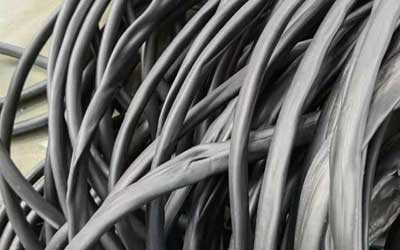Causes and Solutions for "Void Wrapping" in Rubber-Sheathed Cable Extrusion
"Void wrapping" (incomplete adhesion between the sheath and cable core with air gaps) in rubber-sheathed cable extrusion can be attributed to the following causes and solutions:
Cause Analysis
1. Material FactorsPoor rubber compound flow (excessive Mooney viscosity or short scorch time)
Moisture absorption (bubble formation likely when water content >0.05%)
Uneven filler dispersion (e.g., carbon black agglomeration causing localized shrinkage)
2. Process Issues
Improper extrusion temperature settings (melt viscosity spikes when die head temperature is too low)
Insufficient screw compression ratio (<1.8:1, common in extruders below Φ90mm)
Mismatch between haul-off speed and output (over-stretching occurs when speed ratio >1.1)
3. Die Design Flaws
Excessive die land length (>10mm reduces melt pressure)
Improper die tip/die gap (recommended gap = sheath thickness ×1.2)
Oversized flow divider angle (>60° causes weld lines)
4. Operational Errors
Insufficient core preheating (<50°C surface temperature weakens adhesion)
Unstable pay-off tension (>20N variation causes core eccentricity)
Improper cooling (rapid cooling triggers outer layer shrinkage)
Solutions
1. Material ControlSelect rubber with Mooney viscosity ML(1+4)125°C of 40-60
Pre-dry materials (4hrs at 100±5°C, water content ≤0.03%)
Extend mixing time (≥15 mins, ensuring >98% filler dispersion)
2. Process Optimization
Zone temperature control:
Adjust screw compression ratio to 2.0:1-2.5:1
Maintain haul-off speed ratio at 0.95-1.05
3. Die Modifications
Reduce die land to 6-8 mm
Adopt dual-stage pressure dies (internal pressure >0.8MPa)
Implement die tip chamfer (30°-45° transition angle recommended)
4. Operational Standards
Preheat core to 80±5°C (monitored by IR thermometer)
Install tension feedback system (±5N variation control)
Graded Cooling:
Stage 1: Mist cooling (60-70°C)
Stage 2: Water trough cooling (40-50°C)
Quality Verification
1. Cross-Section AnalysisVoid content inspection (<0.5% acceptance criteria)
SEM examination of interface bonding (no delamination at 2000x magnification)
2. Performance Tests
Peel strength ≥3.5N/mm (GB/T 2951.31)
Hot set test (200°C×15min): Permanent deformation <50%
Preventive Measures
Shift-start extrusion pressure check (normal range: 12-18MPa)Weekly temperature sensor calibration (±1°C tolerance)
Implement online X-ray inspection (real-time wrapping monitoring).
